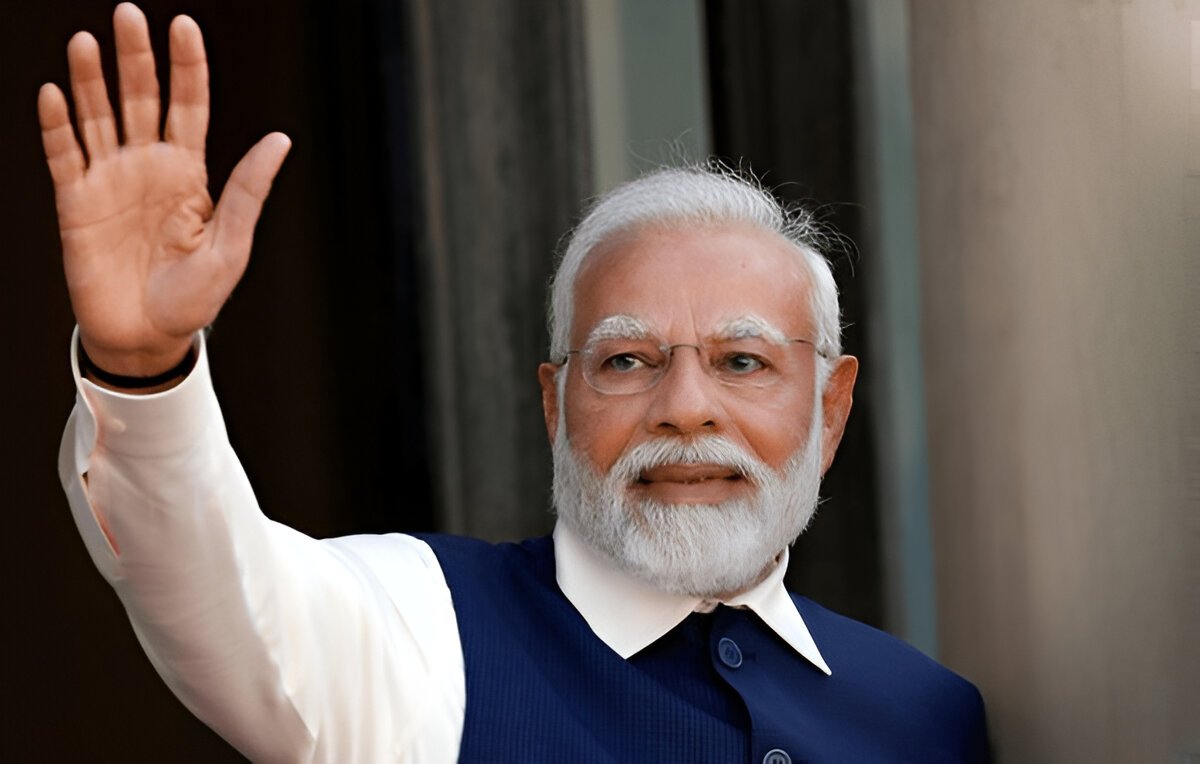Father Of New India


Make in India: Igniting a Manufacturing Revolution
“Make in India” has significantly boosted India’s appeal for foreign direct investment. This success is attributed to a focus on streamlining business regulations, enhancing infrastructure, and cultivating an environment of innovation. The government’s proactive measures, including creating a favorable business climate and implementing policies like the Production-Linked Incentive (PLI) scheme, have motivated companies to set up manufacturing bases in the country. This has resulted in a substantial increase in the production of diverse goods, ranging from smartphones and electronics to automobiles and defense equipment.
- "Make in India" Vision: Symbolized by the "Make in India" lion, this initiative aims for national strength and pride.
- Economic Impact: It has led to increased exports and reduced import dependence, bolstering India's economic sovereignty.
- Sectoral Focus: The initiative targets 25 key sectors to unlock India's potential and integrate its economy into global supply chains.
- Sustainable Growth: By promoting domestic production and entrepreneurship, "Make in India" has laid a foundation for sustainable economic growth.
- Future Goal: The long-term vision is for India to become a global manufacturing hub and for "Made in India" products to symbolize quality and national achievement worldwide.
Shri Ram Mandir Development: A Cultural Revival and National Reawakening
The development of the Shri Ram Mandir in Ayodhya stands as a monumental achievement in India’s history, symbolizing the culmination of centuries of faith and a decisive resolution to a long-standing legal dispute. This project is a powerful testament to the vision of Prime Minister Shri.Narendra Modi, who has championed the revival of the nation’s cultural and civilizational heritage. The temple’s construction is a direct outcome of the Supreme Court of India’s landmark verdict in November 2019, which paved the way for the temple’s construction at the disputed site.
The story of the Shri Ram Mandir is truly heartwarming. It’s a project that brought together our faith and our nation’s spirit, all thanks to a clear vision.
- A Leader's Promise: PM Modi took a big step by setting up a special trust to build the temple, and he personally laid the foundation stone on August 5, 2020. This was a reflection of his strong and decisive leadership.
- A Dream Come True: The temple is a beautiful mix of old-style craftsmanship and modern engineering. The entire project, which cost around ₹1,800 crore, culminated in a special ceremony on January 22, 2024, when PM Modi officially opened the temple. This event marked the end of a very long journey for millions of people.
- More Than Just a Temple: This isn't just a building; it's a powerful symbol of our culture and spiritual pride. It shows how we can come together as a nation to achieve something incredible.
- Bringing Life to Ayodhya: The temple has completely changed the city of Ayodhya. With a new airport, a renovated train station, and wider roads, the city is ready for a new era of growth.
Digital India: Bridging the Digital Divide for a Connected Nation
Digital India is a transformative initiative that has fundamentally reshaped governance and public services in India. Launched with the goal of turning the country into a digitally empowered society, it has been driven by a three-pronged vision: creating a robust digital infrastructure, delivering government services electronically, and promoting universal digital literacy.
The program’s success is most visible in its flagship platforms, which have revolutionized citizen-government interaction. Aadhaar, the unique biometric identity system, has become the bedrock of a new, transparent welfare delivery system, ensuring that subsidies and benefits reach the intended beneficiaries directly, eliminating leakages and corruption. DigiLocker has empowered citizens by providing a secure, cloud-based platform for storing and accessing official documents, making physical paperwork obsolete. The Unified Payments Interface (UPI), a cornerstone of this initiative, has democratized digital payments, allowing even the smallest street vendor to accept cashless transactions with ease.
- The Digital India mission significantly expanded broadband and mobile connectivity, particularly in rural regions.
- This expansion successfully narrowed the long-standing digital divide within the country.
- Programs like the National Optical Fibre Network facilitated the connection of remote villages, enabling access to services such as telemedicine and online education.
- The mission encouraged a dynamic environment for startups and innovators who capitalized on India's digital public infrastructure.
- The overall digital revolution has led to increased empowerment, greater transparency, and the fostering of a knowledge-based economy where citizens are equipped for success and participation in national progress.
UPI: The UPI Revolution: India's Financial Game-Changer
The Unified Payments Interface (UPI), launched in 2016, stands as a monumental financial innovation from India, serving as the cornerstone of its cashless economy. This real-time payment system orchestrates millions of daily transactions, lauded for its revolutionary simplicity and efficiency by individuals, businesses, and government entities alike.
UPI streamlines peer-to-peer and person-to-merchant payments by utilizing a unique UPI ID, thus obviating the need for intricate bank account details and IFSC codes. Its intuitive interface, seamlessly integrated across numerous mobile applications, has democratized digital transactions, extending their reach to a broad demographic, including those previously unbanked or underbanked.
- UPI is widely adopted for transactions of all sizes, from small vendors to large retail chains, using QR codes for payments.
- Its widespread use has reduced reliance on physical cash and increased transparency and accountability in the economy.
- Globally, UPI is a major contributor to real-time digital payments, establishing India as a FinTech leader.
- India serves as a model for other developing nations looking to build digital payment infrastructures.
- Government promotion of UPI has boosted the digital economy and advanced financial inclusion, enabling active participation in a formalized, secure, and efficient financial ecosystem.
Reforms in Tax Laws: Simpler Taxes, Stronger Economy
The Modi government has implemented extensive tax law reforms in India, aiming for a more transparent, predictable, and business-friendly environment. A key reform is the Goods and Services Tax (GST), a “One Nation, One Tax” system that replaced numerous central and state taxes. This simplified the indirect tax structure, reduced tax cascading, and unified India into a single national market, significantly boosting economic efficiency and ease of doing business.
- New Income Tax Bill: The outdated Income Tax Act has been replaced by a new income tax bill.
- Modernized Concepts: This new bill introduces a "tax year" concept and modernizes the definition of digital assets.
- Faceless Assessment Initiative: The government's "faceless assessment" initiative has significantly reduced physical interaction between taxpayers and officials.
- Reduced Corruption and Harassment: The faceless assessment system is widely praised for minimizing corruption and harassment.
- Streamlined Administration and Trust Building: These reforms have streamlined tax administration, fostering greater trust among taxpayers and investors.
Article 370: Unifying India: The End of Special Status
On August 5, 2019, the Indian government made the historic decision to revoke Article 370 of the Constitution, which had granted special status to Jammu and Kashmir for decades. This bold move was based on the principle of “One Nation, One Constitution,” aiming to fully integrate the region into the Union of India and ensure uniform application of national laws and welfare schemes.
The Benefits of Article 370 Abrogation:
- Economic Growth and Investment: The abrogation of Article 370 has removed barriers to development, paving the way for unprecedented economic growth and investment in Jammu and Kashmir.
- Infrastructure Development: The region is now poised for significant infrastructure development, aligning it with the rest of the country's progress.
- Extension of Central Laws: Central laws such as the Right to Information Act and the Right to Education Act now apply to the people of Jammu and Kashmir, ensuring broader benefits.
- National Unity and Integrity: This decision powerfully demonstrated the government's commitment to national unity and integrity, overcoming historical challenges.
- Curbing Separatism and Terrorism: The abrogation has been instrumental in curbing separatism and cross-border terrorism, contributing to a more stable and secure region.
Reforms in Criminal Laws: Modernizing Justice for a Citizen-Centric System
The newly introduced laws—the Bharatiya Nyaya Sanhita, the Bharatiya Nagarik Suraksha Sanhita, and the Bharatiya Sakshya Adhiniyam—are designed to shift the focus from punitive measures to the pursuit of justice. A central element of these reforms is their emphasis on leveraging technology and enhancing efficiency within the legal process.
Key features of this legislative overhaul include:
- Forensic Science Mandate: Forensic science is now mandatory for offenses carrying a sentence of seven years or more, promoting a more scientific and evidence-driven approach to investigations.
- Digital Evidence Recognition: The laws formally acknowledge electronic evidence, such as emails, text messages, and call records, as legally admissible.
- "Zero FIR" Concept: Citizens can now file a First Information Report at any police station, regardless of jurisdiction, empowering the public and ensuring all crimes are recorded.
- Community Service: For minor offenses, community service has been introduced as a form of punishment, reflecting a more reformative approach to justice.
- Streamlined Procedures and Timelines: The reforms aim to deliver swift and fair justice by modernizing trial procedures, streamlining legal processes, and implementing strict timelines.
Atmanirbhar Bharat: Towards a Self-Reliant and Resilient India
The “Atmanirbhar Bharat” (Self-Reliant India) mission is a visionary call to action aiming to transform the nation into a self-sufficient powerhouse. This strategic framework, introduced in response to global disruptions, seeks to establish India as a resilient and dependable partner in the global supply chain. The mission emphasizes building India’s internal capabilities to lessen reliance on imports and become a net exporter of high-quality goods and services, rather than promoting isolationism.
Its foundation is built upon five crucial pillars: Economy, Infrastructure, System, Demography, and Demand. The government has implemented bold reforms under this mission, prioritizing sectors such as defense, mining, and agriculture. A prime example is the decision to ban the import of hundreds of defense items, which has significantly boosted indigenous defense manufacturing, generating new jobs and fostering innovation. Similarly, reforms in the mining and space sectors have been opened to private participation, unlocking immense potential.
-
- This has sparked a national movement to support Indian-made goods.
- The movement aims to strengthen domestic industries and empower local artisans.
- "Atmanbirbhar Bharat" fiscal stimulus packages and schemes support MSMEs and farmers.
- The ultimate vision is for India to be self-sufficient and a significant contributor to the global economy.
Op Sindoor: Securing Our Borders with Precision and Resolve
“Operation Sindoor” symbolizes a new era in India’s national security and military strategy. This metaphorical term represents a decisive and resolute approach to cross-border threats, emphasizing the use of indigenous, cutting-edge technology for precise military actions. This strategic shift marks a departure from past doctrines, demonstrating India’s capability to act preemptively and decisively in safeguarding its sovereignty and national interests. It signals that India will no longer tolerate cross-border terrorism or aggression.
Enhanced National Security:
- Seamless integration of defense forces and intelligence agencies.
- Increased investment in indigenous defense manufacturing and technological innovation.
- Transition to a "Made in India" defense ecosystem.
- Boosted morale of armed forces and strong deterrent message to adversaries.
- Unwavering government commitment to national security and self-defense.
Reforms in Highways and Roads: Accelerating Progress, Connecting India
Over the past decade, India has undergone a remarkable transformation in its road and highway infrastructure, a testament to the government’s commitment to creating a connected and prosperous nation. Flagship initiatives like the Bharatmala Pariyojana have significantly accelerated highway construction, positioning India among the world leaders in road network development. These infrastructure projects extend beyond mere construction; they are the lifelines of a modern India, fostering trade, tourism, and a more integrated national economy.
Infrastructure Development in India
- High-Speed Expressways and Economic Corridors: Dramatically reduced travel times and transportation costs, boosting economic competitiveness.
- Logistics Parks: Further enhanced efficiency in transportation and supply chains.
- All-Weather Roads in Remote and Border Areas: Vital for national security and brought prosperity to previously underserved regions.
- Extensive Metro Rail Networks: Modernized cities and improved quality of life for millions.
- Employment Generation and Economic Growth: Infrastructure projects have been a major source of employment and stimulated ancillary industries, contributing substantially to the nation's economic growth, laying the foundation for a "Viksit Bharat" (Developed India).
Image building of India in foreign land: India's Rise as a Global Power
Under Prime Minister Modi’s leadership, India’s global standing has significantly improved, transforming it from a developing nation into a powerful and influential global force. This shift is due to a proactive, confident, and human-centric foreign policy, with India taking a leading role in addressing global issues like climate change and public health.
A notable achievement was India’s successful G20 presidency in 2023. Championing “Vasudhaiva Kutumbakam” (One Earth, One Family, One Future), India secured the unanimous adoption of the New Delhi Leaders’ Declaration, despite geopolitical divisions. This demonstrated India’s growing influence as a consensus-builder and a rational voice on the global stage.
Global Diplomacy and India’s Role:
- Vaccine Maitri Initiative: India demonstrated global compassion by providing COVID-19 vaccines to numerous countries, solidifying its image as a dependable and selfless partner.
- Empowered Diaspora: The government's active engagement with the Indian diaspora has transformed them into effective national ambassadors.
- Confident Diplomacy: India's new diplomatic approach asserts national interests while simultaneously promoting global cooperation.
- Recognized Wisdom and Values: This era highlights a leadership that ensures India's ancient wisdom, democratic values, and future potential are acknowledged and respected internationally.
- Reinforced Global Standing: These efforts collectively reinforce India's position as a significant and respected player on the global stage.
Diplomatic success in last 10 years: A New Era of Global Leadership
Over the past decade, India’s foreign policy has experienced unprecedented diplomatic success, becoming dynamic and forward-looking under Prime Minister Modi’s leadership. India has emerged as a crucial player in the multipolar global landscape. A key achievement has been the fortification of strategic alliances with major global powers such as the United States, Russia, European nations, and countries in the Middle East.
India’s Evolving Diplomacy
- Rules-Based Order: India actively participates in global forums like the Quad and G20, demonstrating its commitment to a rules-based international order.
- Global Leadership: The Indian-led International Solar Alliance (ISA) highlights its leadership in addressing climate change and promoting sustainable development.
- Voice for Developing Nations: India has strengthened relationships with countries in the Global South, advocating for their aspirations.
- Amplified Soft Power: Initiatives such as the International Day of Yoga have globally expanded India's soft power influence.
- Proactive and Strategic Approach: India's current diplomatic strategy is characterized by confidence, a proactive stance, and a focus on national interests, contributing to global peace and prosperity.
For keeping nation first before self: The Nation First Philosophy: A Guiding Principle
The Modi government’s governance is founded on the principle of “Nation First,” demonstrating an unwavering commitment to the welfare of the Indian people. This philosophy ensures that every policy, decision, and action prioritizes the nation’s and its people’s benefit. This approach has led to bold, long-overdue reforms, sometimes politically challenging but essential for the country’s long-term progress.
Key Principles of Governance
- Nation First: The government prioritizes the country's future over short-term political gains, evident in national security actions and reforms.
- Self-Reliance: The "Nation First" principle is reflected in the push for self-reliance through the "Atmanirbhar Bharat" initiative.
- Transparent Governance: A commitment to transparent governance is central to combating corruption.
- Basic Necessities: The government is dedicated to providing basic necessities like housing, healthcare, and sanitation to the poorest.
- Conviction-Driven Model: This governance model is driven by conviction, not appeasement, believing public satisfaction and national prosperity are paramount, fostering national pride and unity.

